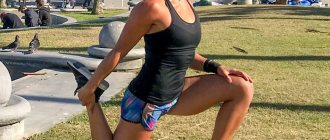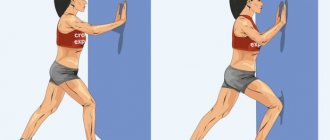Why pre-warm up your body?
Warming up before stretching helps prepare muscle fibers and ligament tissues to absorb stress. Local structures are qualitatively relaxed and become more elastic. The combination of these points reduces the risk of injury.
During pre-warming before stretching, the splits have a tonic effect on the blood vessels. Accordingly, the negative load on the heart is noticeably reduced. Tissues that are subjected to stress during exercise are better saturated with oxygen. The level of endurance increases during active training.
Warming up before stretching seems to be a good method of mental preparation. Such actions make it possible to mentally tune in to the perception of upcoming loads. As a result, there is an increased focus on maintaining the correct technique for performing stretching exercises.
Warm-up for splits: indications and contraindications
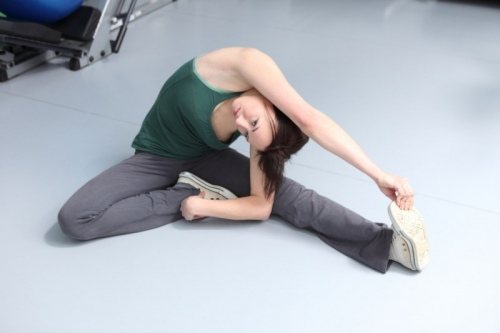
With any physical activity, it is extremely important to consider your body's starting state and give it a load that it can handle. In order for training aimed at doing the splits to be effective and safe, the muscles and joints must be prepared for the upcoming loads.
If muscles are not used during everyday movements, the body becomes weaker. To prevent this, you need to stress absolutely all the muscles and joints of the body. The ability to do the splits is precisely an indicator of excellent health of the ligaments and joints.
It’s not for nothing that splits are included in many programs of therapeutic and preventive physical education. This type of stretching can be used by both absolutely healthy people and those who have medical indications . The list of the latter includes the following:
- Lack of abdominal muscle tone, need for stimulation of internal organs.
- Compensation for overexertion due to lack of mobility and inactive lifestyle.
- Low level of mobility of the hip joints, caused by trauma in the past.
Not everyone can do the splits. Contraindications in this case include injuries and inflammatory processes in the knees, ligaments and tendons of the groin, spinal injuries, abnormalities of the hip joints, as well as exacerbation of gynecological diseases.
First steps

When starting to warm up before stretching, first perform a set of active body movements while maintaining high intensity. We are talking about running in place, rotating the lower limbs over a wide amplitude, raising the knees to chest level. It is also useful to jump rope for a few minutes. Finish with a series of deep squats. The main task here is to create a feeling of slight heat in the extremities. The presence of an effect indicates a good warming up of the muscles, which allows you to move on to more complex exercises.
An effective complex for the muscles of the whole body
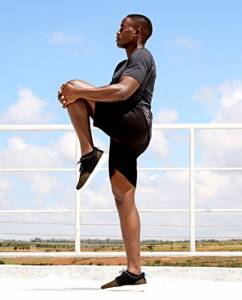
Even if you are training just one area (back, arms or chest), warm-up should be done on all parts of the body. Stretching exercises for beginners include:
- Cardio warm-up.
Stretching necessarily begins at this stage, which increases the intensity of the heart, increases pulse and temperature, dispersing blood throughout the body.
Exercise options:
- running in place;
- walking with your knees raised high.
Execution time – 2-4 minutes.
- Joint warm-up.
The purpose of this block is to develop the joints, gradually preparing them for loads. This type of stretching is necessary before any exercise, regardless of whether it is performed with weights or your own weight. As a rule, it consists of rotations with the elbows, shoulders, arms and hands. The pelvis, knees and feet are worked in the same way.
Each element is performed at least 10 times at a medium-intensive pace.
- Dynamic gymnastics.
Here the load is applied specifically to the muscles of various parts of the body.
Options:
- Arm extension (the pectoral and dorsal muscles are stretched, the shoulder blades are brought together, the elbows are always located above the wrists).
- Retraction of the arms behind the head and to the sides (the head is turned in the opposite direction, the triceps and shoulder joints work).
- Bends to the side and towards the legs - the legs are straight when tilted (the abdominal muscles, oblique and rectus abdominis muscles, and partially the muscles of the back of the thigh work).
- Lunges forward and sideways (the muscles of the buttocks and thighs are prepared, coordination and balance are trained).
- Tilts to the toes while sitting. This ensures stretching of the quadriceps and hamstrings. You can complicate and increase the effectiveness of the exercise by grasping your foot and pulling your body towards it in a sitting position, using your hands.
Each element is performed 8-10 times, without rest intervals at an average pace.
Important! Exercises designed to stretch tendons and ligaments can cause serious damage if performed incorrectly or too intensely. It is necessary to monitor the correct execution of the exercises, and if severe pain appears, immediately stop performing them and postpone the training until the condition normalizes.
At the end of this stage, you can do a little cardio training, for example, the simplest jumps with simultaneous extension of your arms and legs.
- Restoring lung function.
At the end of the warm-up, it is necessary to restore even and calm breathing. To do this, just stretch up as you inhale and lower your body as you exhale, allowing your arms to hang down freely. Duration – 0.5-1 minute.
Expert opinion
Evgeniy Kislitsa
Practicing surgeon. Certified massage master. Two-time vice-champion and heavyweight champion of regional kettlebell lifting competitions.
You can perform exercises to restore breathing, following any technique known to the trainee. The most common and simplest version of exercises to restore breathing is to inhale through the nose with a smooth rise of the arms and exhale through the mouth with a smooth lowering of the limbs. Performing a tilt, as indicated above, is a purely individual preference of the trainee. The duration of the complex to restore breathing is also purely individual. Therefore, you should not adhere to clear boundaries (they are usually averaged). It is recommended to perform exercises until breathing is completely normalized.
Exercise "Butterfly"

After completing the above set of actions, proceed to the next exercise. Take a sitting position on a gymnastics mat. Bend your legs in front of you, placing your feet together and your knees in opposite directions. Your shins should lightly touch the floor surface. Try to keep your back straight. Begin to gently swing your lower limbs up and down, like the flapping of a butterfly's wings. Move your knees up and down for several minutes.
Warming up before stretching according to the marked scheme makes it possible to thoroughly relax the muscles and ligaments in the groin area. It is this area that is most often subject to injury if an athlete neglects to prepare the muscles to accept loads before performing the splits.
Lunges forward

How to warm up your muscles before stretching? Achieving the desired result will allow you to move into a runner's position at the start. Take a vertical body position. Smoothly take a wide step with your right foot in the frontal direction, placing your foot firmly on the floor. Move your left limb to your toes. Place your palms in front of you at the level of your feet extended forward. The thigh of the right leg should be parallel to the floor. Keeping your back straight, slowly pull the toe of your left foot back. Feel the stretch in the back of your thigh. Then stand up and lunge forward again, alternating your lower limbs.
Recommendations from professionals
Good music, along with a boost of energy, will lift your spirits. Ideally, it should be a mix at different tempos. At the beginning of the warm-up, it is better to use upbeat melodies that set a high tempo. When it comes to more complex exercises that involve deep stretching, calm compositions are better suited.
Full warm-up - you can watch the exercises in the videos suggested above, or use the complex compiled yourself.
Basic stretching involves calmly working out a selected muscle group and holding it in certain poses for quite a long time.
Having received theoretical knowledge, it is worth starting practice.
Video: How to do the splits? Opening of the hip joints
Body tilts in a sitting position
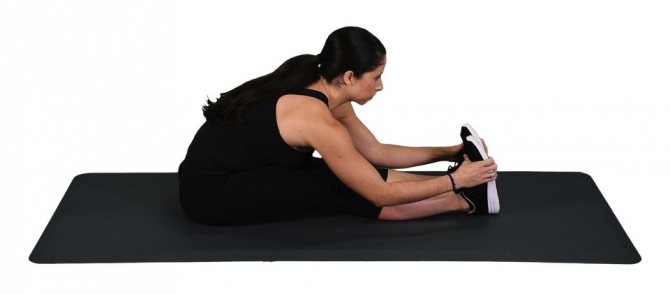
Sit comfortably on the gymnastics mat. Keep your back straight. Bring your lower limbs together and extend them in front of you. Avoid bending your legs at the knees. From this position, gently tilt your body forward. Perform a high-quality deflection in the lumbar region. Stretch your head in the direction of your feet. Straighten your arms and extend them in the frontal direction, parallel to the floor. Perform the exercise every time you plan to stretch your body. The ultimate goal of the training is to assume a position where the stomach and head lie freely on straight legs.
Stretching before cross splits
- Place your feet shoulder-width apart, with your knees, feet, and hips turned outward. Slowly begin to lower your pelvis under yourself - open your knees outward. Fix the pose, do not sit down. Start to pull the pelvis towards the floor, swaying evenly.
- Raise one leg in a standing position, move your knee to the side. Grab your knee with one hand, the other can be held on your belt or lean on a chair. Slowly straighten your leg until it is parallel to the surface. Socks also pull. Repeat the steps in reverse order.
- Place your feet wider than your shoulders, arms at your sides. Bend over each leg one by one, trying to reach the floor with your hands as much as possible. Stay in each position for at least 20 seconds. If you have difficulties, you should contact a personal fitness trainer.
- Do a classic side lunge. Your heels should be well on the floor. Grasp the knee of the supporting leg with your hand, and connect the fingers of both hands behind your back. Hold the lock for at least 30 seconds, the spine should be straight. If the lock doesn't work, you can clasp your hands in front of you.
- Sit on your heels with your hips wide open. The buttocks should aim towards the floor. The back remains straight. Start turning your body in each direction with a straight back. After finishing this exercise, you need to move your body forward, lie with your hips, hands on the floor, connecting your feet (the exercise is called “frog”, ideal for cross splits).
- Lie near the wall, buttocks should be pressed against it. Stretch your legs up, alternately, without bending, lower them to the floor. In this case, the foot is flat, the heel rests on the wall.
Warming up before stretching for the splits is mandatory. Each time you can add new activities that will allow you to quickly develop your muscles and prepare them for the splits.
Recommendations! If any movements are difficult or painful to do, it is better to replace them with something easier, and then return to performing them. A gymnastic band, a mat, and special stretching equipment will help you master them.

Useful tips
To achieve a good warm-up of the muscles before stretching, use the following tips:
- Try to study in the evening. After moderate physical activity throughout the day, the muscles respond to exercise much better. Accordingly, the training is more effective.
- Warm up your muscles in comfortable clothing that provides increased comfort and does not restrict movement. Shoes are optional. It is better to train barefoot, placing a gymnastic mat on the floor.
- A good alternative to performing a set of exercises to warm up the muscles is taking a bath. Sit in warm water before your planned stretch for 15-20 minutes. Then dry your body thoroughly with a towel, put on sportswear and proceed directly to training.
Some useful tips
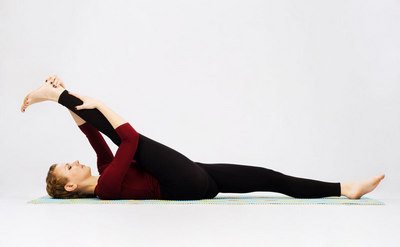
It wouldn't hurt to remember a few more useful tips.
- The morning hours are a great time for regular exercise, but stretching is easier to do in the evening (during the day, standard loads on the muscles warm up and partially stretch them naturally, and the effectiveness of the same movements becomes higher).
- It is extremely important to choose sportswear that is comfortable for you personally and specifically designed for such activities. Both the comfort of the suit and the material used to sew it play a role - after all, the intensity of bending, lunging, jumping and running is very high. Whether you choose leggings or loose-fitting sweatpants for this is not so important.
- Shoes. One, even the most universal pair, is not enough. Because it is better to do intensive warm-up in sneakers, and stretching - in ballet shoes, slippers, or even just in socks or barefoot.
- Warming bath. Sitting for at least 15 minutes in fairly hot water (if “these days” or other reasons do not interfere with this) means guaranteeing excellent warming up of the muscles. Which will bring us one more step closer to the cherished split.

